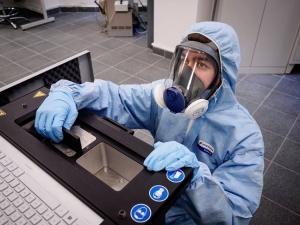High-class 3D printing lab in Świerk
13-06-2016
3D printing lab equipped with the first in Poland high-class 3D printer has started operations in NCBJ. The printer may print elements from such materials as steel, bronze, gold, silver, aluminium, and titanium alloys.
NCBJ scientists have developed and fully equipped a 3D printing lab. Its key elements include a high-class 3D printer, a high-class optical scanner, an environmental chamber, and an industrial tomograph. Equipment has been put in operation in the Świerk Science and Technology Park.
„The just put in operation 3D printing lab is an example of our innovation-oriented attitude” – pointed out Professor Krzysztof Kurek, NCBJ Director General. – „As the first entity in the country we can now offer small and medium-size companies access to technology that may give them a significant competitive edge on the market. We offer not only access to equipment and know-how, but also a number of additional services, such as business consulting, legal assistance, technology assessment, assistance in filing for patent applications, planning industrial utilization of patents”.
The 3D printer recently purchased by Świerk scientists is the first in Poland machine capable to print elements from such materials as steel, bronze, gold, silver, aluminium, and titanium alloys. Depending on the material, printing accuracy is about 50 micrometres. Maximum size of elements the machine is capable to print is 92 x 92 x 96 mm. The elements are cost-effectively produced from bulk materials. The most stringent environment protection regulations are observed during production runs. The printer may not only mass-produce identical elements (like many other machines), but is also capable to start to print another element right after finishing an entirely different one – without a need to re-tune the machine. Material losses are inevitable in every production process, but in that case they are limited to just 2%. 3D printing finds numerous applications in prototyping (which is a very important application for developers of unique research infrastructure), production of complicated spare part for aeronautic/automobile industry, making custom-tailored medical implants (orthopaedic bone implants). Since no specialized production line must be set up and configured, such printers are unsurpassed in terms of speed (often also in terms of costs) if a limited number of some elements must be quickly produced. Assignment accomplishment lead time is often shorter than 24 hours since the moment the order is placed. 3D printer operated in NCBJ is accessible for small and medium-size businesses on the DeMinimis assistance basis.
3D optical scanner produces virtual models of elements scanned by its special camera. Neither complicated shape nor unusual structure of the scanned element is any obstacle. Some appropriate software converts the scans into technical blueprints necessary for re-creating the element using a 3D printer. The scanned elements may be as large as 460 x 420 x 420 mm (single scan), scanning accuracy may reach 10 micrometres. The scanner is particularly useful if there is a need to re-create an element lacking any technical documentation (e.g. parts of old prototypes, archaeological finds etc.).
While 3D optical scanners re-create shapes of the scanned elements, industrial tomographs can peek into their internal structure. Images acquired by such tomographs help to identify materials of which the elements are built, and to detect micro-cracks and/or other internal faults in the materials; such faults may considerably affect usability of the elements. Industrial tomograph operated in Świerk may scan both large objects and micro-scale objects such as electronic integrated circuits. Main function of the tomograph operated in our 3D lab is to assess on the spot the quality of the 3D-printed elements. The results help to master the 3D-printing process and to estimate lifespans of the printed elements.
Environmental chamber can be used to test devices not larger than 850 x 740 x 970 mm in controlled condition: temperature within the –75…+180⁰C range changed at the maximum rate 5⁰C per minute, relative humidity within the 10…95% range, vibration level (sinusoid or random mode), impacts of forces of up to 6,000 N. Such tests must be routinely performed by manufacturers of every day appliances, who need to test their products introduced to the market or to look for defects in their solutions/designs. Tests of new mobile phone models may be an excellent example: phone must remain operational during both frosty winters and hot summer seasons, in rain and in draught, and the connection must remain stable even while driving on a very bumpy road.
„Beside the 3D printing lab, our Science and Technology Park houses several other labs, which are unique in Poland” - said Piotr Warzybok, MSc, in charge of coordination of the Park research infrastructure – „We offer also a modern conference centre. One of the events recently organized in the centre was ISROS2016 symposium” (a meeting of representatives of community interested in reliability of optoelectronic systems, including manufacturers of aeronautics/supporting electronics such as Airbus, Thales, VigoSystems, CNES; more info: www.isros2016.ncbj.gov.pl).
Services offered by several other Park labs include nano-mechanical tests, radiation modification of materials, and clean room built to the ISO class 8 standard. The entire Park (a project co-financed from the Regional Operational Programme for the Mazovia Voivodeship) was devised as an assistance centre helping to quickly implement to national economy/commercialize innovative results of scientific research, and to grow innovative HiTech businesses founded on knowledge/know-how of researchers. One of the Park’s objectives is also to stimulate growth of the entire Mazovia region.





